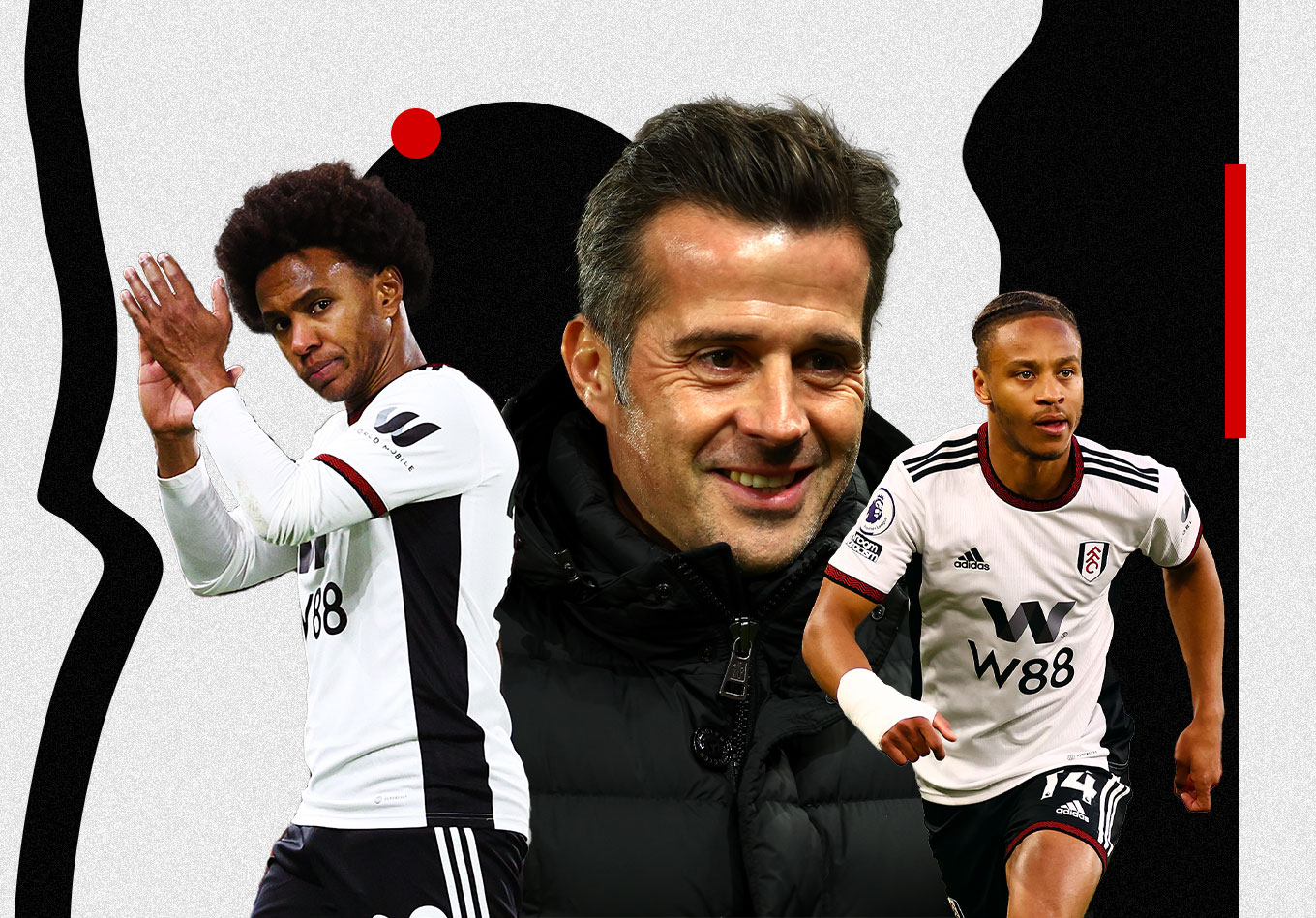Fulham did something few teams have done before by finishing in the top half of the Premier League in their first season after promotion from the Championship, but is there reason for some caution amid the optimism?
There isn’t a Premier League team for whom this isn’t a big summer. Even Manchester City have some reinforcing to do if they are to maintain anything like the level played at in winning the treble last season.
One might think that Fulham, having finished 10th in their first season back in the top flight, could rest on their laurels a little. But the truth is, perhaps more than for many of their rivals, there is a lot of work to be done.
That’s largely because they will hope to be planning for the long-term in the Premier League, and finishing in the top half is no guarantee of sustained top-flight status. While Wolves (promoted in 2018), Newcastle (2017) and West Ham (2012) have all stayed up ever since they followed promotion with a top-half finish in their first season in the Premier League, the fate of Sheffield United and Leeds in recent years provide cautionary tales. Both secured top-half finishes as newly promoted sides before respectively being relegated one and two years later. And there are a few reasons for caution at Craven Cottage; the first being that their underlying numbers suggest they weren’t quite as good as their hugely impressive league position might initially have you believe. Fulham significantly outperformed their expected goals at both ends of the pitch.
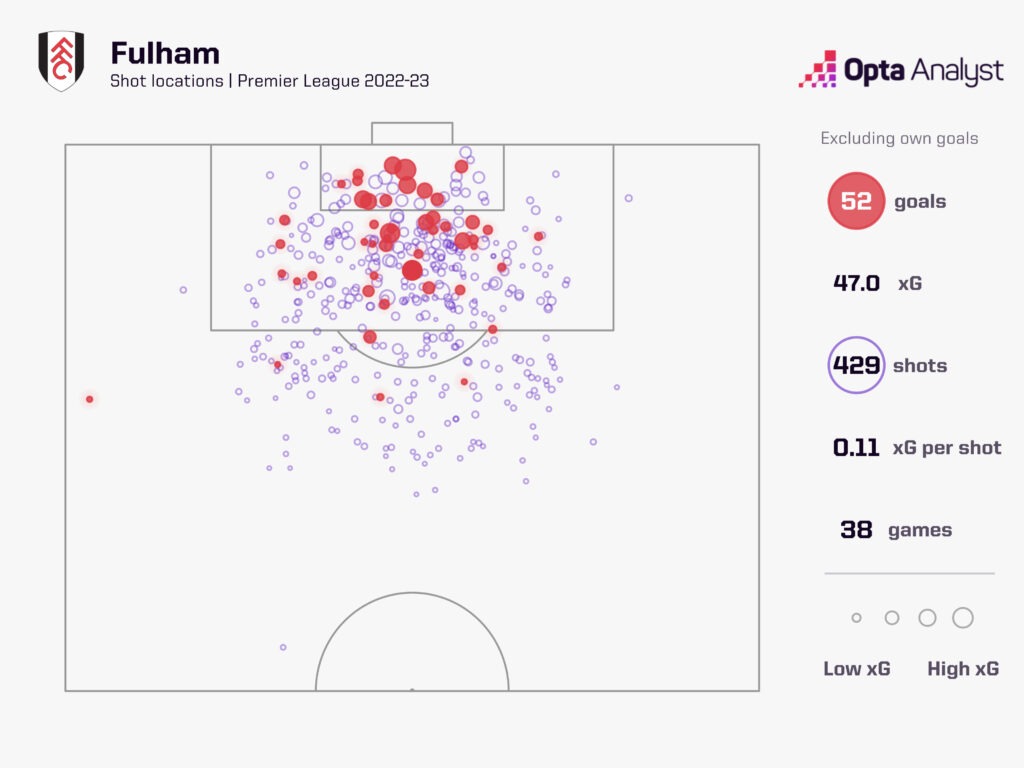
They scored 52 goals (excluding own goals) from 47.0 xG in 2022-23, with their overperformance of 5.0 the fourth highest in the Premier League, behind City (11.5), Arsenal (10.7) and Tottenham (10.2).
In other words, Fulham scored five more goals than the chances they created were worth (plus three more own goals). It wasn’t, as you might expect, 14-goal Aleksandar Mitrovic responsible for their record in attack (he actually underperformed relative to his 14.9 xG), but Manor Solomon (four goals from 1.2 xG), Carlos Vinícius (five from 3.3 xG) and Willian (five from 3.4 xG). They also conceded 51 goals (excluding own goals because own goals have no xG value) from 62.5 expected goals on target conceded, meaning they let in 11.5 fewer goals than our expected goals model suggests they should have from the shots on target they faced. Their overperformance in this regard was the best in the Premier League.
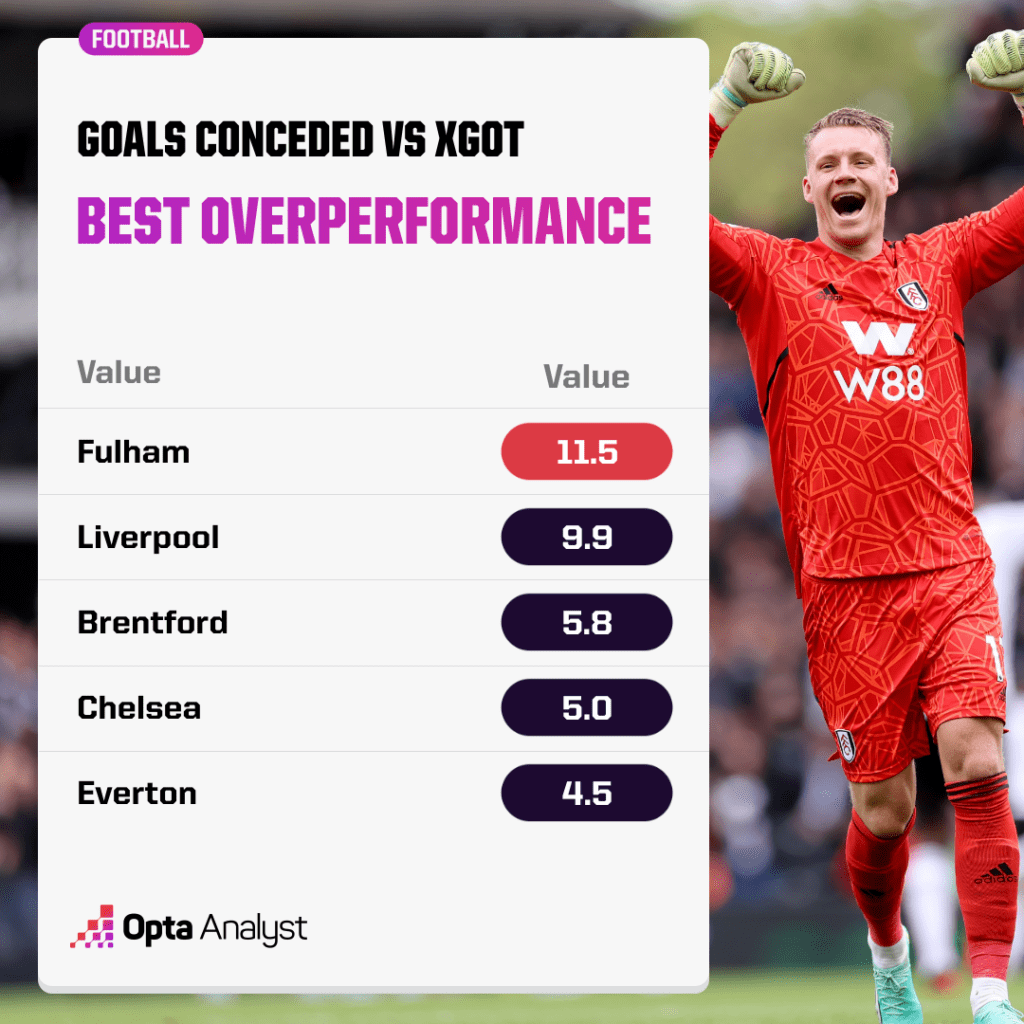
Bernd Leno’s goals prevented rate – the number of goals he ‘should’ have conceded from the shots on target he faced for every goal he actually conceded – was 1.25, the highest of any goalkeeper to play more than 300 minutes last season. That is, for every four goals he let in, the averagely performing goalkeeper would have conceded five.
So, based on both how they created chances and how they defended, they might well not have finished in the top half. If they create the same chances and allow shots of similar quality in a comparable volume next season, they could easily revert to the mean and fall down the table.
There is also the issue of squad profile at Fulham. They had the second-oldest average age of their starting XI in the Premier League, at 28 years and 239 days – just eight days younger than the oldest side, West Ham. They also gave only 96 minutes all season to players aged under 21 years old, which was the 11th-lowest in Europe’s top five leagues.
Those numbers alone aren’t necessarily problem. Newcastle and Manchester City ranked fifth and sixth oldest in the Premier League for the average age of their starting XIs and both had successful seasons, while Serie A winners Napoli were one of only two teams in Europe’s top five leagues not to hand a single minute of game time to an under-21 player.
But it does pose a problem for the longer-term future for manager Marco Silva, who will surely need to be thinking about how much longer he can rely on the likes of Bobby De Cordova-Reid (29 Premier League starts in 2022-23, now aged 30), Tim Ream (33 starts, age 35) and Willian (25 starts, age 34).
Silva clearly values experience and wants leaders on the pitch in the shape of older players. Willian is well aware of the fact that his role now stretches beyond just being a key player for Fulham.
“I’m not a guy who shouts,” he told Opta Analyst. “You’ll never see me on the pitch shouting [at] or kicking a player, but I have a different kind of leadership. It’s like technical leadership within the team. I feel I had an important role in the team.” He was indeed crucial to Fulham’s success. Willian was involved in more open-play sequences in Premier League games than any other teammate (112) despite playing only 2,143 of a possible 3420 minutes (63%). He also, unsurprisingly, topped the club’s charts for involvement in open-play sequences per 90 minutes played (4.7 per 90).
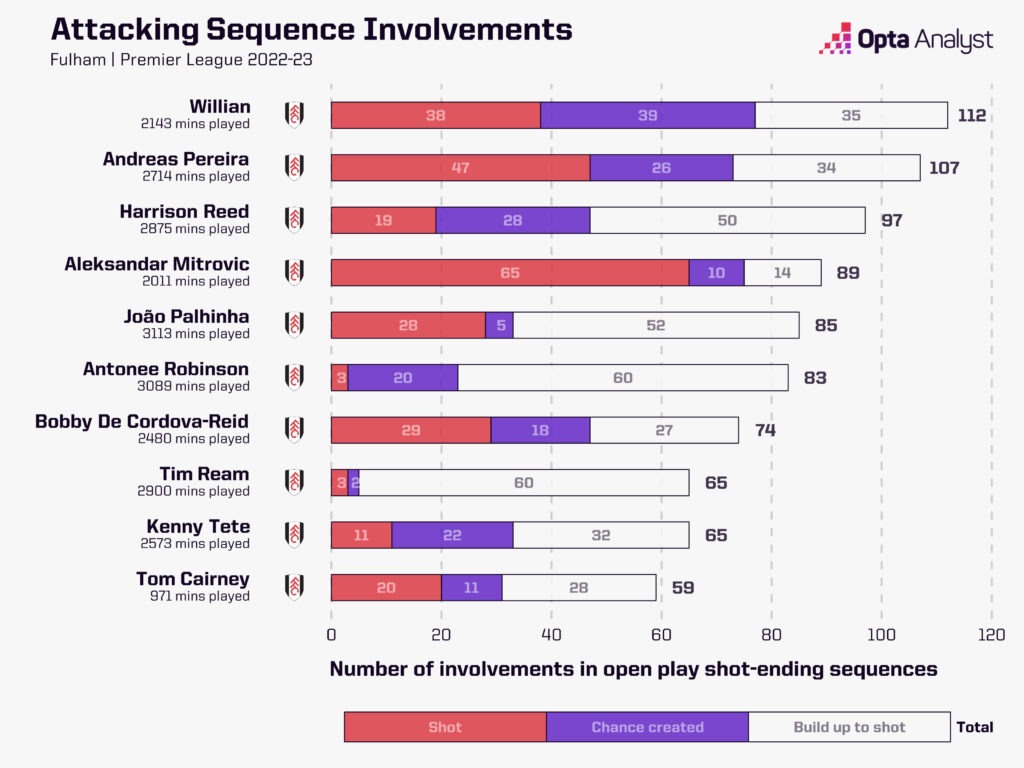
Willian credits Silva for reviving his career after a disappointing spell across the capital at Arsenal and then a year in Brazil with Corinthians. Back in west London, where he thrived with Chelsea, the Brazilian has been exceptional.
“Without a doubt, I was very happy to come back to the Premier League at Fulham,” he said. “Unfortunately, at Arsenal things didn’t happen the way I wanted. It was a difficult moment for the club, a transition, a lot of people leaving, players leaving and arriving. But at Fulham, I regained the confidence that I had at Chelsea. Playing loose, playing happy, playing with joy. This is what I rediscovered at Fulham.”
Silva getting his team playing with such confidence and freedom may help, at least in part, explain why they outperformed their xG so well. He also placed a lot of focus on “ideas for set-pieces, which [were] important for the team,” according to Willian. Fulham outperformed their xG at set-pieces by 3.7 goals – the biggest overperformance in the Premier League in 2022-23 – with Willian getting three assists directly from dead balls, which was the third-highest figure in the whole top flight, behind Kieran Trippier and Andy Robertson (both four).
Crosses were vital to Fulham’s open play, too. Their absolute width – the average width of their moves during open-play sequences – was the widest in the Premier League, at 25.6m, and they attempted more open-play crosses than any other team, with 582, or 15.3 per game.
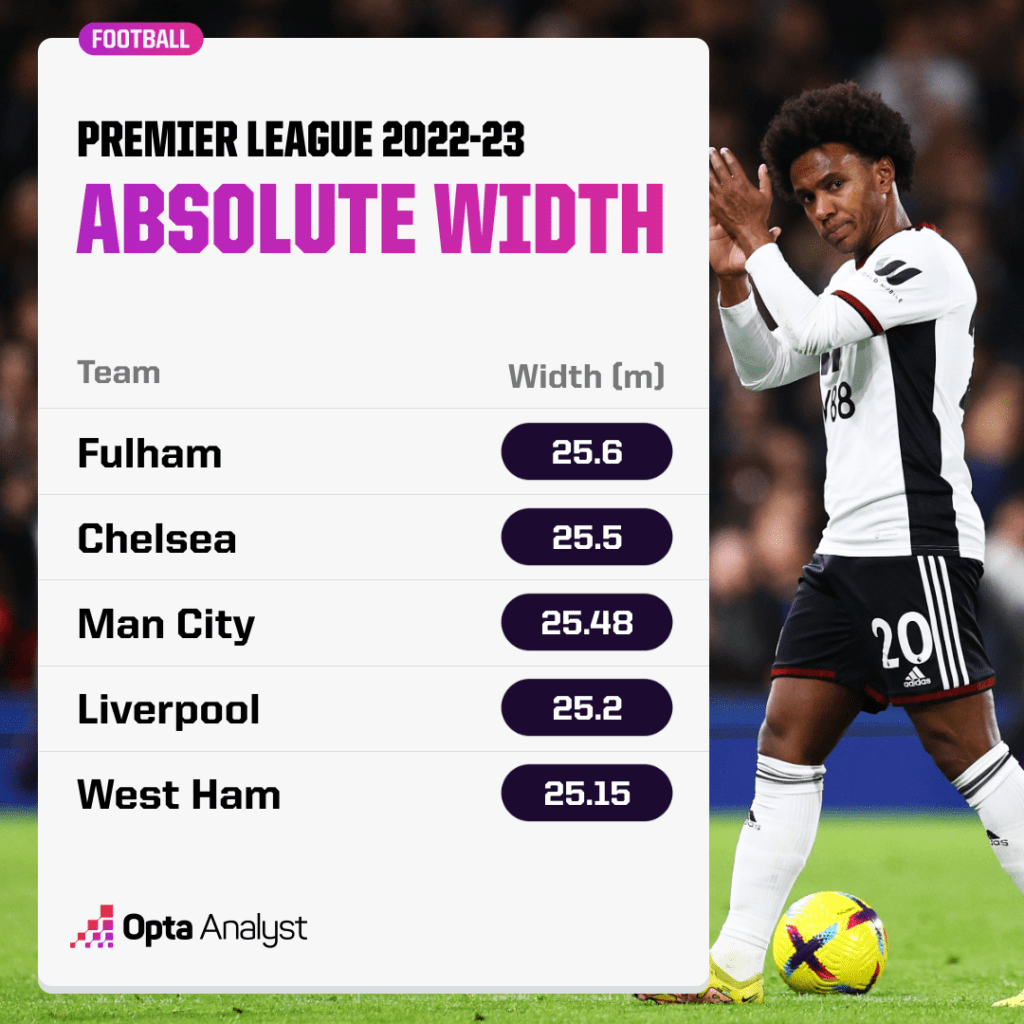
After attacking with so much width, and therefore leaving big gaps between players, it didn’t make sense for them to press. They ranked third-from-bottom in the top flight last season for high turnovers (263), third-bottom for shots following a high turnover (37), and had the seventh-highest average figure for passes per defensive action (13.5). With a front three of Willian, Cordova-Reid and 28-year-old big man Aleksandar Mitrovic, it just wasn’t in the game plan to press. Energy had to be conserved.
When the opportunity did present itself and there was space to exploit, though, they were keen to attack at pace. Only five teams – Manchester United, Newcastle, Liverpool, Chelsea and Tottenham – launched more direct attacks, which are defined as open-play sequences that start inside a team’s own half and see more than 50% movement towards the opposition’s goal before a shot, than Fulham (63). It wasn’t as though Fulham defended deep and counter-attacked, though, ranking firmly in mid-table for the average distance that their open-play sequences started from their own goal (41.5m). This meant their attackers didn’t have as far to travel to goal once the ball was turned over and their direct attacks could be shorter.
It was wonderfully efficient, and Fulham were one of the most consistent teams in the entire Premier League. They spent 40 consecutive weeks in the top half of the table, never outside the top 10 after August, which is some achievement for a promoted side. “I think that the unity and effort of everyone have helped us stay in the top half of the table for such a long time,” reflects Willian, when asked for the secret to his team’s success.
Whether what they did last season is sustainable or if they can repeat the trick in 2023-24 are the big questions for Silva and the club heading into the summer. It may be that some investment in younger players is necessary as they look to the long term. In the meantime, though, Silva’s tactics, experienced players performing and a bit of feel-good factor at Craven Cottage could be enough for another year.
Enjoy this? Subscribe to our mailing list to receive exclusive weekly content. And follow us on Twitter too.
